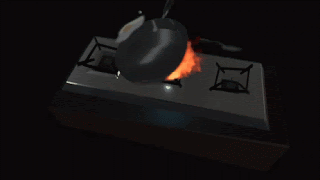Science Primary 4: States of Matter
Read the lesson materials below!
States of Matter
A. What Is Matter?
Objective:
Understand the concept of matter and identify its different forms.
Introduction
Matter is everything around us. It makes up the air we breathe, the water we drink, and the objects we touch. Let's explore what matter is made of.
Content:
1. Definition of Matter:
Matter is anything that has mass and takes up space.
2. States of Matter:
Matter can exist in different states: solid, liquid, and gas.
B. What Are the States of Matter?
Objective:
Differentiate between the three main states of matter: solid, liquid, and gas.
Content:
1. A Solid:
Characteristics/Properties of a Solid:
- A solid has a fixed shape and fixed volume (definite shape and volume).
- Particles of solids are closely packed together and vibrate in place.
Example: Ice.
More examples of solids:
- Wood: Solid and has a definite shape and volume.
- Plastic: Solid but can be molded into various shapes.
- Rock: A solid material found naturally on Earth.
- Metal (e.g., Iron): Solids with distinct properties and often used in construction.
- Paper: Solid in sheet form but flexible.
2. A Liquid:
Characteristics/Properties of a Liquid:
- A liquid has a variable shape and fixed volume (definite volume but takes the shape of its container).
- Particles are more spread out than solids (Particles of liquids are more loosely packed compared to solids, allowing them to flow and take the shape of their container).
Example: Water.
More examples of liquids:
- Milk: Takes the shape of its container but has a fixed volume.
- Juice: Liquid with a definite volume and the ability to flow.
- Honey: Viscous liquid that flows very slowly.
- Soda: Liquid that fizzes due to dissolved gases.
- Oil: Liquid that doesn't mix well with water.
3. A Gas:
Characteristics/Properties of a Gas:
- A gas has a variable shape and variable volume (no definite shape or volume).
- Particles move freely and fill the entire space.
Examples:
- Air: Mixture of gases, including nitrogen, oxygen, and carbon dioxide.
- Oxygen (O2): Essential gas for breathing.
- Nitrogen: A gas that makes up much of the air in Earth's atmosphere.
- Helium: Gas lighter than air, often used in balloons.
- Hydrogen (H2): A flammable gas.
- Carbon Dioxide (CO2): Gas exhaled by humans and used in carbonated beverages.
C. What Happens When Matter Is Heated or Cooled?
Objective:
Explore the changes in matter states when heated or cooled.
Content:
1. Melting:
Solid to liquid.
Example: Ice melting into water.
2. Boiling:
Rapid change from liquid to gas.
Example: Water boiling into steam.
3. Evaporation:
Slow change from liquid to gas at the surface.
Example: Puddles drying after rain.
4. Condensation:
Gas to liquid.
Example: Water droplets forming on a cold glass.
5. Freezing:
Liquid to solid.
Example: Water freezing into ice.
6. Sublimation:
Solid directly to gas.
Example: Dry ice turning into carbon dioxide gas.
D. More Examples of Daily Life Activities or Phenomenon on the Changing States of Matter
Objective:
Relate the concepts learned to everyday occurrences.
Content:
1. Melting:
Ice cream melts on a hot day.
2. Boiling:
Cooking pasta in boiling water.
3. Evaporation:
Wet clothes drying in the sun.
4. Condensation:
Fog forming on a cool morning.
5. Freezing:
Making ice cubes in the freezer.
6. Sublimation:
Dry ice creates a smoky effect.
E. How Can We Use Solids, Liquids, and Gases Safely?
Objective:
Understand the safe use of different states of matter.
Content:
1. Solid Objects:
Handle objects like iron nails, knives, and broken glass carefully to avoid injuries.
2. Liquids:
Use caution when handling liquids like oils, pesticides, and bleach, and be mindful of their potential harm.
3. Gases:
Store and safely use gases like cooking gas, following recommended guidelines and precautions.
Safety Tips:
Always ask for adult supervision when dealing with potentially hazardous materials.
Conclusion:
Congratulations, young scientists! You've explored the fascinating world of matter, understanding its different states and how they change. Remember to use this knowledge safely in your everyday life. Keep questioning, keep exploring, and stay curious!
Happy learning! 🌟✨
Now, let's warm up before a quiz!
Report Card
Total Questions Attempted: 0
Correct Answers: 0
Wrong Answers: 0
Percentage: 0%
Note: Capture/screenshot the report card, and submit it to Google Classroom! And then, accomplish the following quiz!
Now, let's have the quiz!
Click the picture below to complete the homework!
Thank you for learning, my students! \^_^/



















